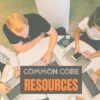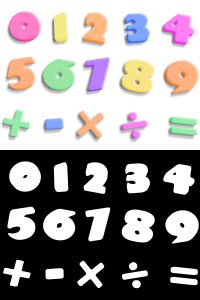Search Results for: common core
Free Lesson Plans–Visit My TeachersPayTeachers Store
 Looking for something to spice up your classroom? Here are a variety of projects you can download for free. Just visit my TeacherPayTeachers store, click download, and they’re yours. If you enjoy them, please add a few stars to the recommendation list:
Looking for something to spice up your classroom? Here are a variety of projects you can download for free. Just visit my TeacherPayTeachers store, click download, and they’re yours. If you enjoy them, please add a few stars to the recommendation list:
A Colonization Brochure in Publisher
A Publisher trifold on American colonies (or any
other topic you’re covering in your classroom). Includes step-by-step directions, standards addressed, time required, prior knowledge expected, vocabulary used, higher-order thinking skills addressed, samples, reproducibles, grading rubrics, and more.
Students interpret the words of Dr Martin Luther King in their own words in a visual organizer. Great project that gets students thinking about impact of words on history. Common Core aligned
Share this:
Subscribers: Your Special is Available
Every month, subscribers to Ask a Tech Teacher get a discounted resource to help their tech teaching.
This month:
THE KEY TO ALIGNING YOUR K-5 CLASS WITH COMMON CORE STATE STANDARDS:
30 Projects that integrate technology into core lesson plans
Why do I need this book?
The Key to Aligning Your K-5 Class with Common Core State Standards is for classroom teachers, technology integration specialists and lab professionals, as a resource for aligning your technology program with the Common Core State Standards now implemented in forty-six states. You will find it a foundational tool for scaffolding technology into the areas of math, language, reading, writing, speaking and listening as is required in CCSS. Overall, they are authentic approaches to student-centered learning, asking the student to be a risk-taker in his/her educational goals and the teacher to act as guide. The essential questions are open-ended and conversations organic and inquiry-driven, ultimately asking students to take responsibility for the process of their own learning.
Share this:
Dear Otto: How Do I Prepare for an Unknown Tech Future?
 Dear Otto is an occasional column where I answer questions I get from readers about teaching tech. If you have a question, please complete the form below and I’ll answer it here. For your privacy, I use only first names.
Dear Otto is an occasional column where I answer questions I get from readers about teaching tech. If you have a question, please complete the form below and I’ll answer it here. For your privacy, I use only first names.
Here’s a great question I got from Sandy:
For the pass 10 years I have taught computer for 3K and 4K Early Education. Also each year that I have taught they have added a grade level to my schedule. So at this point I now teach 3K, 4K, and Kindergarten through 4th grade. I would like to take some continuing education courses in this field to better educate my students. I have already taken the Microsoft Office 2007 Master Certification Course and I intend on taking the Microsoft 2010 course as well (even though I passed the course using the Office 2010 software, I would just like to have the more updated certificate). I am also looking into taking a “Computer Support Technician” Certificate Program. My question to you is…do you have any suggestions on courses that I could take to educate myself more in this field to keep up with the fast technology pace, especially with our young kids today educating themselves through all of today’s tech devices? Currently I concentrate on Keyboarding Skills, Computer Parts and Terminology, Research, Online Safety, proficiency in MS Word, Excel, and Power Point. What do you suggest?
I think the best approach is to develop your PLN, connect with tech professionals who you trust, and shares thoughts, ideas, lesson plans. Attend any conference (like ISTE or local ones) that you can to see what’s happening. Try everything that inspires you. Blog with your students. Get them on wikis. Have them create Storybirds and Animotos and iMindmaps. Some will work. Some you’ll learn from. Browse your e- colleagues and see what they’re doing.
Share this:
Weekend Website #108: Wowzers
Every Friday, I share a website (or app) that I’ve heard about, checked into, been excited to use. This one covers math. Since ‘math’ is by far the most popular search term of readers who seek out my blog, I know you’re going to enjoy this review.
[caption id="attachment_9730" align="aligncenter" width="614"] Math learning for students; evidence for teachers[/caption]
Math learning for students; evidence for teachers[/caption]
Share this:
Weekend Website #107: Google Search Education
Every Friday, I share a website (or app) that I’ve heard about, checked into, and become excited to use. This one is tools available for teachers to help their students maneuver the often-tricky machinations of the internet.
[caption id="attachment_9718" align="aligncenter" width="614"]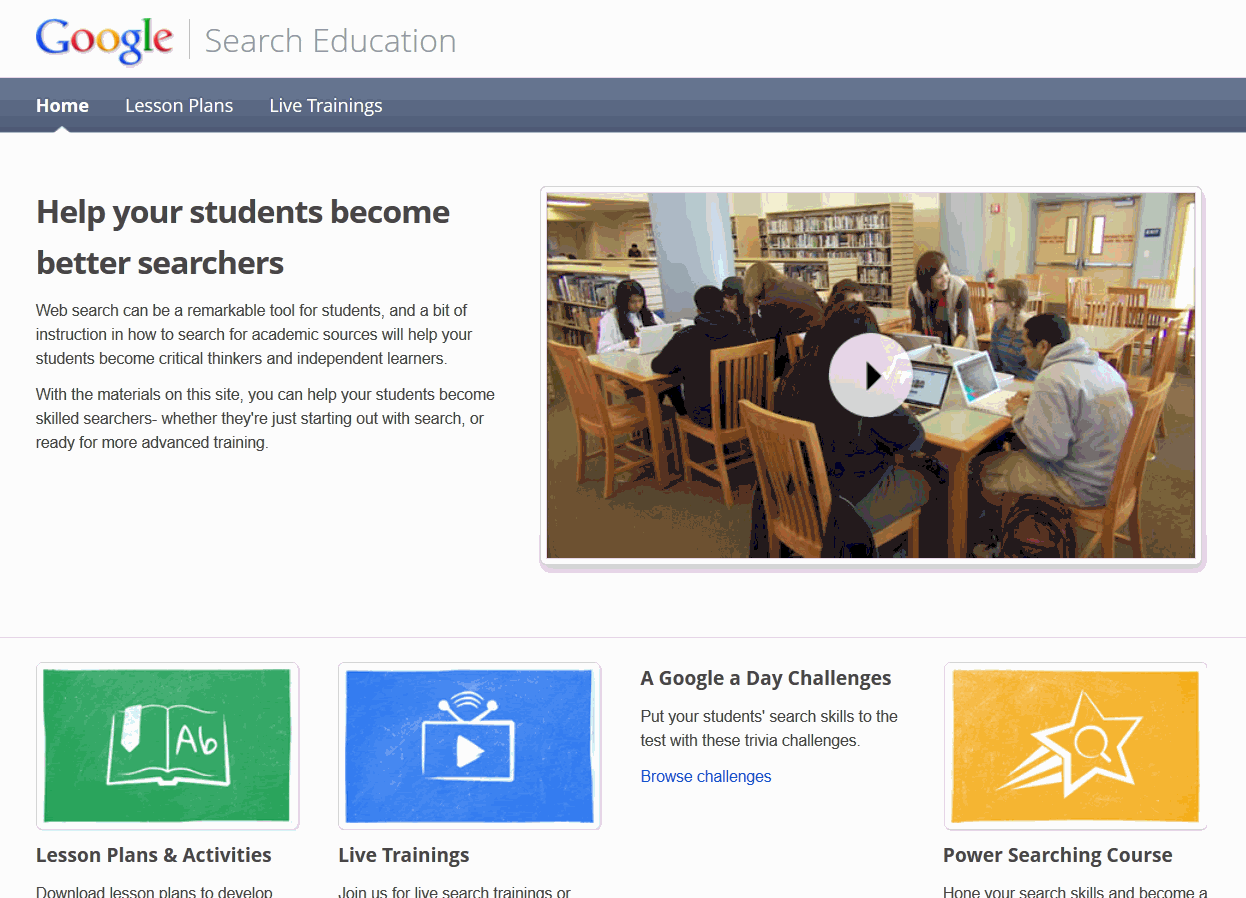 A complete course in how to search using Google[/caption]
A complete course in how to search using Google[/caption]
(more…)
Share this:
Dear Otto: My computers are old. What do I do?
 Dear Otto is an occasional column where I answer questions I get from readers about teaching tech. If you have a question, please complete the form below and I’ll answer it here. For your privacy, I use only first names.
Dear Otto is an occasional column where I answer questions I get from readers about teaching tech. If you have a question, please complete the form below and I’ll answer it here. For your privacy, I use only first names.
Here’s a great question I got from Laurie:
There are a lot of teachers trying to keep up with tech ed changes despite older labs and computer set-ups. Some are lucky with 1:1 set-ups and classroom iPads, but lots of teachers make do with what they have.
Like you, I don’t have a smartscreen. Our IT guys attached my computer to a screen (probably like your Epson) so I can display samples and rubrics, and I have Splashtop on my iPad so I can get back to my screen from anywhere in the classroom (albeit, it’s a bit clunky) so that-all helps. I have students come up to the screen and point or share–a way to involve them more in the lessons. At times, I let them use my computer–when I flip the class and have them teaching a skill. This is quite popular.
Share this:
The Elephantine Impact of Technology on Education
Have you noticed what’s happening in your child’s school? Technology. There’s rarely a lesson taught, be it math or science or health, that doesn’t include some form of technology
 to enhance its message, increase its reach, improve its communication. If you haven’t been in the classroom lately, drop by this week when you pick up your wonderful student. There’s likely to be a Smartboard (or some sort of interactive screen) on the wall, a pod of computers (if not 1:1 laptops) overflowing from a corner, maybe iPads on desktops or in a mobile cart, a digital camera and microphones to record events, streaming video from Discovery Channel. Those ubiquitous samples of student work that traditionally clutter the walls now include many created with computers.
to enhance its message, increase its reach, improve its communication. If you haven’t been in the classroom lately, drop by this week when you pick up your wonderful student. There’s likely to be a Smartboard (or some sort of interactive screen) on the wall, a pod of computers (if not 1:1 laptops) overflowing from a corner, maybe iPads on desktops or in a mobile cart, a digital camera and microphones to record events, streaming video from Discovery Channel. Those ubiquitous samples of student work that traditionally clutter the walls now include many created with computers.
Today’s education happens by standing on the shoulders of technology innovation.
If you don’t have a school-age child, take a peek at Cisco’s VNI Service Adoption blog. There’s an uptick in the impact of technology on all parts of consumer life. As Cisco suggests, these changes are all about connecting students to their future, empowering them with responsibility for their own education in areas such as:
- access to learning
- quality of instruction and education assessment
- innovative learning models
- decision making
- reduced costs with administrative efficiency (not yet, but it’s a good goal)
Share this:
Math
- CK12 Math help
- EquatIO (Texthelp)–free for teachers; integrates into Canvas
- Generation Genius–K-8 math and science videos
- Good Calculators
- Google Earth in Math
- King of Math (app)
- Learn Multiplication facts—for fun
- Mathantics
- Math Basics Plus
- Math edutainment
- Mathematica–from Wolfram Alpha; desktop, cloud, and mobile device
- Math for K
- Math in REal Life–from TEDEd: 167 lesson plans
- Math Minutes
- Math practice—requires subscription
- Math Science Music
- Maths Dictionary
- Math skills links
- Mathway–make printable worksheets
- New Assistments--aligns with your math curriculum
- Operation Order – Funbrain
- Order of Operations
- TED talk on math and computers
- TEDEd talks on math
- Transum Math
- Virtual Manipulatives
- XPMath–teacher guides, math games for lots of ages; aligned with CC
- XtraMath–master basic math facts
- Yummy Math–math in the news
Algebra
- Algebra curriculum (pretty thorough but might be dated)
Automaticity
Curricula
Games
Geometry
Graphs
Lesson Plans
- Common Core-aligned
- Math bundle for K-8
- Mathalicious–teach with real-world situations; lesson plans for older students
Math Apps
Math Facts
- Math Duel–duel against a friend while learning math facts (app)
- Sushi Monster–math facts from Scholastic (app)
Math Programs
Numbers
Number Square
- Build a number square
- Find Owl’s Friends–number square
- Happy Numbers
Self-paced programs
Simulations
Videos
Word Problems
Activities from Eric Curts
 Blog post – “11 Ways to Teach Math with Google Drawings” – Website link
Blog post – “11 Ways to Teach Math with Google Drawings” – Website link Help Guide – “Teaching Math with Google Drawings” – Google Document link
Help Guide – “Teaching Math with Google Drawings” – Google Document link Training video – “Teaching Math with Google Drawings” – YouTube Video
Training video – “Teaching Math with Google Drawings” – YouTube Video Blog post – “Interactive Clock Face with Google Drawings” – Website link
Blog post – “Interactive Clock Face with Google Drawings” – Website link Interactive Clock Face template – Google Drawing link
Interactive Clock Face template – Google Drawing link Blog post – “Creating Fractions in Google Slides and Drawings” – Website link
Blog post – “Creating Fractions in Google Slides and Drawings” – Website link Blog post – “Pattern Block Templates and Activities with Google Drawings” – Website link
Blog post – “Pattern Block Templates and Activities with Google Drawings” – Website link
Math–2nd Grade
Math–3rd Grade
Math–4th Grade
Math–5th Grade
Math–MS
Math–HS
Share this:
9 Steps to Tech Savviness This Summer
Summer is for change. Out with routine, in with spontaneity. When you were in high school, that meant relaxing, seeing friends, going to parties. In college, it likely meant a summer job to make the money that paid for college. Now, as an adult, living your future, summer is a time to rejuvenate, to enrich, to build your core–those things that make you who you are.
for college. Now, as an adult, living your future, summer is a time to rejuvenate, to enrich, to build your core–those things that make you who you are.
As a technology teacher or IT coordinator or computer specialist (or all of the above), you need as much time as you can get and more than you have during the school year to stay afloat of what’s happening in the tech ed field. The list of changes is daunting–iPads, 1:1 initiatives, technology integration, podcasts, sharing and publishing student work, embeddable widgets, Common Core State Standards, digital citizenship, keyboarding. If you’re like me, you try to do what you can during the school year, but it’s summer, with its endless days and no schedule that gives you the freedom to let your brain lose.
Here’s my bucket list for this summer:
Share this:
Books
Here is a list of books currently available to assist you in integrating technology into your K-8 classroom:
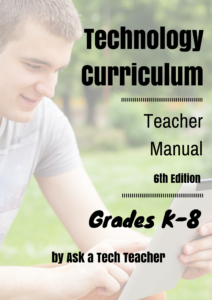 Kindergarten through Twelfth Grade Technology Curriculum
Kindergarten through Twelfth Grade Technology Curriculum
32 lessons Every Child Can Accomplish on the Computer
The choice of hundreds of school districts, private schools and homeschoolers around the world and tens of thousands of students, this nine-volume tech ed curriculum is the all-in-one solution to running an effective, efficient, and fun technology program for kindergarten-twelfth grade (each grade level textbook sold separately) whether you are the lab specialist, IT coordinator, or classroom teacher. Each lesson is aligned with both Common Core State Standards* and National Educational Technology Standards, and includes an Essential Question, Big Idea, suggested Assessments, required materials, vocabulary, problem solving, teacher preparation required, how to extend learning, examples, grading rubrics, additional resources, and how students can collaborate/share projects. Using a tested approach that promotes literacy, critical thinking, problem-solving, and decision-making, students learn the technology required to prepare for their future. The secret for you, as teacher, is knowing what to teach and when.
Each textbook is 212-252 pages with 218-301 images. Each text includes a wide-ranging Scope and Sequence, 32 weekly lessons, monthly homework (3rd-8th only), student Certificate of Completion, articles that address tech pedagogy, and posters ready to print and hang on your walls.
With your purchase, you receive FREE access to a wealth of online resources including hundreds of teacher materials that differentiate instruction, websites that extend learning, and free help from professionals using the curriculum (membership included with purchase). Student workbooks extra.
Available in print and digital from:
Teachers Pay Teachers (digital)
Publisher’s website (print and digital)
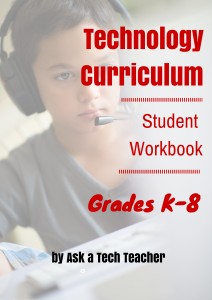 Student workbooks for Technology Curriculum--10 volumes
Student workbooks for Technology Curriculum--10 volumes
Support K-12 Technology Curriculum
10 grade-level technology curriculum student workbooks (kindergarten through 12th grade) with teacher manuals (see Technology Curriculum above) and teacher videos. Aligned with the Structured Learning K-12 technology curriculum (which is aligned with Common Core and ISTE)–one ebook per grade level. Each ebook is 148-203 pages, with 251-406 images.
This is a student-paced, student-directed course that integrates with any school curriculum and prepares students for end-of-year Common Core testing.
Not available individually–only available as a room, site or District license.
Available in digital only:
Teachers Pay Teachers (ebooks)
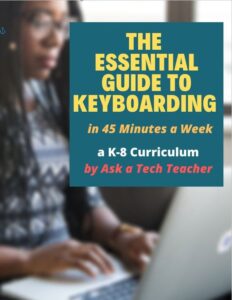 The Essential Guide to Keyboarding for K-8
The Essential Guide to Keyboarding for K-8
in 45 minutes a week
The book includes:
- A summary of the literature
- Answers to questions like ‘Can youngers learn to keyboard—and should they?’
- Importance of the teacher
The K-8 curriculum includes a lot more variety than keyboard exercises on installed software. Here’s a rundown of pieces used:
- Keyboarding software (yes, you do need repetition)
- Online keyboarding websites
- Age-appropriate use of hand covers
- Quarterly speed/accuracy quizzes
- Quarterly blank keyboarding quizzes
- Monthly homework
- Wall charts to support learning and display evidence of success
- Grading based on student improvement, not conformity to class norms
- A Scope and Sequence of keyboarding skills by grade
You’ll learn practical strategies on how to blend these pieces, each added at the right time, to teach the keyboarding skills required for today’s classroom. Each lesson includes:
- Overview
- Objectives and steps
- Best Practices
- Extensions
- Trouble-shooting
- Where to get help
Note to readers: Color shown in the sample image gallery are included in PDF version only.
Available in print and digital from:
Teachers Pay Teachers (ebook)
Structured Learning (print and digital)
 Ultimate Guide to Keyboarding–2 volumes
Ultimate Guide to Keyboarding–2 volumes
- a comprehensive approach to teaching keyboarding–lots of detail, numerous illustrations so it’s easily understood even by teachers who don’t teach tech for a living. Rich in detail so everyone can understand it.
- supports Common Core needs in the form of yearly testing and Standards requirements for a tech-infused classroom
- detailed timeline of what to introduce when. Starts weekly and moves to monthly as teachers become more comfortable with how to integrate keyboarding into their classroom
- can be used with or without optional student workbooks and videos. All three products are fully aligned so students and teacher are at the same point any moment in time.
- a comprehensive approach to teaching keyboarding–lots of detail, numerous illustrations so it’s easily understood even by teachers who don’t teach tech for a living. Rich in detail so everyone can understand it.
- supports Common Core needs in the form of yearly testing and Standards requirements for a tech-infused classroom
- detailed timeline of what to introduce when. Starts weekly and moves to monthly as teachers become more comfortable with how to integrate keyboarding into their classroom
- can be used with or without optional student workbooks and videos. All three products are fully aligned so students and teacher are at the same point any moment in time.
Available:
Teachers Pay Teachers (ebooks)
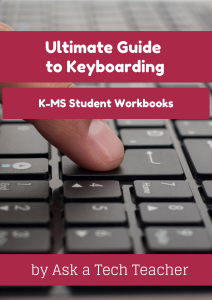 Student workbooks for Keyboarding
Student workbooks for Keyboarding
Support Ultimate Guide to Keyboarding
7 grade-level student keyboard workbooks (kindergarten through Middle School) to accompany teacher two-volume Ultimate Guide to Keyboarding. One for each grade K-Middle School, delivered digitally, to enable students to self-pace, self-manage their year-long keyboarding journey from wherever they are.
Each is about 80 pages long with 40-50 illustrations.
Includes:
- Why learn keyboarding?
- formative and summative assessments
- domain-specific vocabulary
- relevant problem solving
- required digital citizenship overview
- Embedded links available so students can simply click and go—no searching for the site, typing in addresses, trying to remember the site address
- Samples of projects at student fingertips so wherever they’re practicing, they have an example and directions
- Background material right there. If student wants to remember what they did a week–a month–ago, it’s right there.
- Workbook goes with the student. It’s licensed to them through the school. If they’re in the library, the classroom, the soccer field, they can practice. Even at home.
These workbooks encourage independence in student keyboarding learning and require only nominal direction from a teacher, homeschooling parent, or another adult. These are perfect if keyboarding is taught across classes at your school—not in the tech lab–or taught in a home environment.
Not available individually–only available as a room, site or District license.
Teachers Pay Teachers (ebooks)
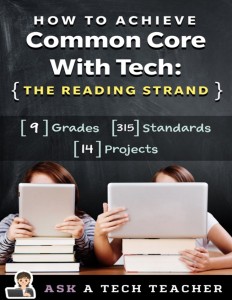 Common Core lesson plan books
Common Core lesson plan books
Themed to the strands–language, math, reading, writing, speaking/listening
Common Core–Lesson Plans organized by strand: How to Achieve Common Core with Tech is a five-book series that focuses on using technology to meet Common Core standards in Language, Writing, Reading, Speaking/Listening, and Math.
Throughout the 150+-page Common Core roadmap to educational reform, it’s clear the 21st Century learner requires technologic proficiency—digital dexterity to fuel the ‘college and career’ engine. One example: Common Core assessments will be completed online—only possible if students use technology as comfortably as paper and pencil to demonstrate knowledge. To accomplish this requires a seamless integration of technology into classroom curricula.
This series makes that happen. You see how to use computers, websites, tablets, graphic art, infographics, web widgets to scaffold what you already teach–easy-to-understand tech tools, no more complicated than the iPads and manipulatives you already use.
Each lesson includes
- Common Core standards addressed
- NETS-S Standards addressed
- Vocabulary used
- Time Required
- Grade level recommended and suggested background
- Essential Question
- Big Idea
- Materials required and teacher preparation
- Step-by-step directions
- Help with tech problems
- Extensions—how to differentiate and dig deeper
Available in digital only:
Teachers Pay Teachers (ebooks)
 33 Common Core Lesson Plans
33 Common Core Lesson Plans
This book is for classroom teachers, technology integration specialists and lab professionals, as a resource for aligning their technology program with the Common Core State Standards now implemented in states across the country. You will find it a foundational tool for scaffolding technology into the areas of math, language, reading, writing, speaking and listening. Overall, these lesson plans provide authentic approaches to student-centered learning, asking the student to be a risk-taker in his/her educational goals and the teacher to act as guide. It can be used as a resource book, to provide exciting new lessons that seamlessly blend technology with curriculum and involve the many new tools available to enrich educational experiences, or as a road map, plotting the vertical planning and differentiated instruction fundamental to CCSS goals.
Lessons are divided by grade level. Each includes: 1) Common Core State Standard alignment, 2) Essential Question the Big Idea, 3) Overview, 4) Objectives and Steps, 5) Sample (where appropriate), 6) and additional grade levels suitable for the lesson.
- audio stories
- blogging
- brainstorming
- collaborative writing
- how-to directions
- creative book review
- digital storytelling
- essential ingredients to stories
- explore the world
- parts of a whole
- write stories in comics
- estimate, visualize, verify
- arrays
- GE Literary Tour
- GE research
- math
- online communication tools
- practice letters and words online
- research–source authenticity
- shapes are everywhere
- timelines
- word recognition
- The Common Core State Standard alignment
- The Essential Question—the Big Idea
- An Overview
- Objectives and Steps
- A Sample (where appropriate)
- Links to related websites and material (where applicable)
- Additional grade levels suitable for the lesson
Available in print and digital from:
Teachers Pay Teachers (ebooks–the complete K-5 book or bundles of grade-level lesson plans)
Structured Learning (print and digital–entire book or grade-level bundles)


